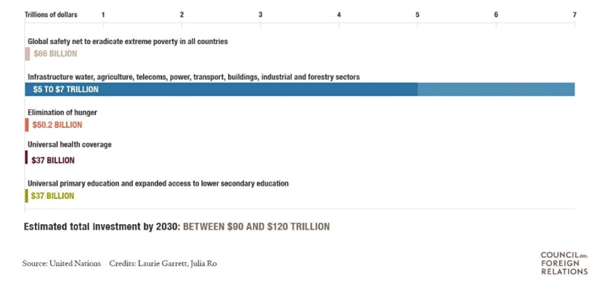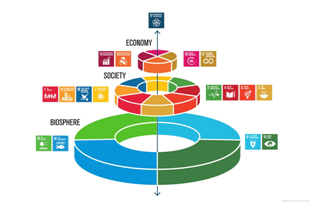Achieving SDGs through sport – Episode 5
Dr. Gilles Klein, 30 October 2017
Russian
Last Monday, we left off on a question as vast as it was intriguing: Forests, physical education, youth sport, who will pay? It is a question of common sense or rather a matter of matriochki, these Russian dolls of decreasing size placed one inside the other. First of all, is it desirable to ask who will pay the bill for of the transformation of the world and then to understand how youth sport can be the beneficiary of part of that? However, the news makes me start with the little matriochka, that is to say, to reverse the reasoning by leaving in space a moment of the global agenda to come without digression to our target: the financing of the youth sport.
Lausanne
To achieve this, today, we will make a detour via Lausanne, where the seminar Achieving SDGs through sport was held on 5 October. In the Olympic capital, the political and institutional world of sport questioned how sport can contribute to the UN 2030 program and the achievement of the Sustainable Development Goals (SDGs). The question of the participation of sport in the achievement of the universal objectives was of course at the center of the debate by the implementation of Article 37 of the United Nations program. The financing of sustainable development through sport recurred in the panelists' interventions.
Mandela
Can sport, and under what conditions, contribute to transforming the world? Nelson Mandela would probably have had a lot to say on this issue. Last March, we paid tribute to the memory of South Africa’s father and his "truth and reconciliation"[1] policy inspired by the African philosophy of Ubuntu[2]. In this reconciliation, there was no question of sport, but of pain and physical and moral atrocities. Yet, for the former leader of the ANC, sports was an essential tool in the reconciliation process of the communities. In 2000, he declared: "Sport has the power to change the world. It has the power to unite people in an almost unique way. Sport can create hope where there is only despair. It is more powerful than governments in breaking down racial barriers. Sport is played out by all types of discrimination ". Sports was for Mandela both an idea, an ethic, a policy. It was, above all, a daily tool for renewing broken links in local communities.
Humble
If Mandela inspires our approach, his humility obliges us. Throughout the episodes, I feel and will always feel obliged to remember an obvious humility - the pleasure of a sports spectacle or the passion of its practice may seem far removed from the ambition to change the world. After all, winning or losing a football match, an athletics competition, is the only sport that is a long way from the happiness or misfortune of a person's life or the fate of the world.
Field
However, like Mandela, all athletes know this. The training stadium or the competition arena are tremendous places to address issues of inequality and human rights, respect for nature and environment. The physical education course or school sports training is a privileged space for education on issues of gender, social inclusion, respect for others and diversity. The fitness gym, and sometimes the weight training workshops, offer special moments for health prevention, hygiene education, and food or learning lifestyles. It is during the meeting of a small club office meeting or the board of a federation that one learns the alphabet of governance and the fight against any form of corruption. Wherever it is on the planet, it is in the diversity of these sports venues that children and young people begin to perceive the great societal issues that they will encounter throughout their lives. It is within a small community, in local space, that raising awareness of more global issues begins.
Never
As if the skeptical interlocutors were to be persuaded constantly, mass sports is indeed a privileged place for the transmission of values that allow us to tackle the great challenges of the world and is a privileged means of building day by day the conditions required to have a real impact on sustainable development. In this blog, I will return to the ethical issues that I summarized at the Lausanne seminar thus: "Never the universal of the SDGs voted by heads of state at the UN without the universal designed as the result of local communities, of local actions and shared situations ".
Lausanne
This local inscription of the SDGs was a recurring theme in the debates of the seminar in Lausanne: local environment, natural spaces, daily activities, mass sports, field actions, pedagogical relations, transmission of values, etc. But to pursue the investigation of this question of a hypothetical transformation of the world through sport, I will retain another recurring theme in the work carried out in the Olympic capital. A red thread linked all the organizations present there. This is, how to be surprised, the question of financing or investing in sports as a means of sustainable development.
Impact
Almost all the representatives of the sports institutions mentioned this. This was the case in the first panel devoted to the sustainable development policy of the International Olympic Committee (IOC). The international sailing federation demonstrated the necessity of engaging plasturgy, manufacturers and distributors, in defense of the environment and against plastic pollution, called the seventh continent, as the polluted areas are as vast as a continent. FIFA questioned the relevance and reorientation of Corporate Social Responsibility (CSR) programs. Since 2005, the specialized department of this federation has taken this issue very seriously and has since worked towards a positive impact on society and the environment. UN agencies asked about financial resources, their origin, and the relevance of their investment in good or bad sectors. The Commonwealth Sports Department pointed out the lack of public-private partnerships (PPPs) in the sports sector and questioned the private sector's risk of investing in sustainable development through sport using these means.
Wine
On the way back from Lausanne, crossing the vineyards of the canton of Vaud, which produce the Top Ranked Growths of Chasselas and Chardonnay wines, I thought: "Vineyard words, PPP is old wine in new bottles! To implement its policy, the organization I represented in Lausanne, World Sports Alliance, used PPPs to (try to) finance youth sport. As early as 2007, we relied on one of Kofi Annan's initial recommendations at the beginning of the MDGs era.
PPP
"Good governance" must be the key factor in the success of the MDGs, the Secretary-General of the United Nations said. In order to compensate for the budgetary constraints of the States, public-private partnerships (PPPs) were considered vital for this cause. By associating central and local governments, civil society and business, they could form meaningful and productive partnerships. We have explained[3] and presented[4] our model, but it must be admitted, on this road, our attempts were more numerous than our successes. We shall have the chance to return to the reasons for this mixed result.
Invent
That is why, for the SDGs era, we have decided to diversify the sources of funding for youth sport. I will focus on that in these columns because it is a major issue. At this precise moment in the SDGs era, at this particular moment of youth sport, we must invent ways and means of financing which are more in line with the innovation economy and with the challenges of the world. In Lausanne, in my communication[5] and in the text[6] on which it is based, I have, in turn, touched on the question of the financing of sport.
Finance
Leaving aside the underlying analysis, let's come to the main conclusions. In the global North, against a backdrop of successive economic crises, public funding regresses drastically. The global South has no financial autonomy and must invent new ways of financing its sustainable development. The international financial institutions emphasize that this development can only come from coordination between the public and private sectors, even requiring a strong contribution from the latter. This was one of the outcomes of the Addis Ababa conference in July 2015, which sought a comprehensive agreement on financing for development. After this detour via Lausanne, we will return to Addis Ababa.
Azimuth
To finance youth sport, like the competitor of the orienteering race, it will be necessary to consider all the azimuths before choosing the right directions. Let’s consider some of these azimuths. If states continue to withdraw, PPPs will remain a relevant intermediary, especially in Africa, building on the subsoil richness. If the reference to the private sector becomes major, companies will be able to constitute an important reservoir of financing. Thus, by adopting Ecological, Social and good Governance (ESG) policies, which associate the Sport for Development and Peace (SDP) dimension, companies would benefit from a commitment to a kind of citizen sports sponsorship allowing them to benefit from fiscal advantages.
FinTech
There is another way. Insofar as the internet has become an indispensable net for all, the financing of sports projects by crowd-funding can also be an interesting solution. Getting a project online can bring substantial funds together. And since we will have to innovate, here is another azimuth. To the extent that the digitization of the world is inevitably intensifying, the new financial technologies (FinTech) offer interesting short-term prospects to facilitate the raising and distribution of funds - blockchain, clearing platforms, digital currencies, etc. Whether it is for macro financing to build sports facilities or for micro-credits to finance a young person's business, FinTech will be a valuable tool.
Citizen
In Lausanne, I concluded an argument on the prospects for financing youth sports in the SDGs era in these terms: "Decline in public funding, importance of the local level, innovation by the fiscal interest of citizen sponsoring, or crowd-funding, whatever may be in the future for sport, as for any economic activity, it will be necessary to spend more economically, rationally and efficiently. This will involve the creation of new financial institutions specific to the financing of sport - such as a World Youth Development Center, an investment fund, and a micro-credit fund - and a better evaluation of all stakeholders in the design and implementation of SDP programs ".
New flower
In 2000, sports was a tool for reconciliation against the apartheid background in South Africa. In 2015, sports are a tool for promoting and achieving SDGs against the backdrop of economic crisis in a globalized world. It was necessary to make this detour via Lausanne. But we have to pursue our journey because, in order to understand the conditions for funding youth sport, we cannot ignore the global funding for the transformation of the world. It began in Addis Ababa - a new flower in the Amharic language - in July 2015, shortly before the vote of the seventeen (17) SDGs. And the least we can say is that the record was not very good.
Next: Monday 6 November 2017 – Transform the world: Lausanne - Addis Abeba.
[1]On April 15, 1996, the first hearing of the Truth and Reconciliation Commission was held. Archbishop Desmond Tutu in charge of this delicate file, opened the work: detentions, executions, tortures, rapes, disappearances. Nearly 20,000 victims will testify.
[2]Recall that the Ubuntu proclaims that we are what we are thanks to what others are.
[3]Klein, G. (2014), Las Políticas Deportivas Nacionales y la Cuestión del Desarrollo en un mundo Globalizado: 2007-2013, la Experiencia de una organización intergubernamental (OIG-AMD), E-Balonmano.com: Journal of Sport Science, Ano 2014, Vol. 10, http://bit.ly/2ylElJw
[4]Klein, G. (2013), Sport as driver
of the national development in the WSA Member States, Doha GOALS, Gathering of All Leaders in Sport, Doha, 9-11 December 2013.






